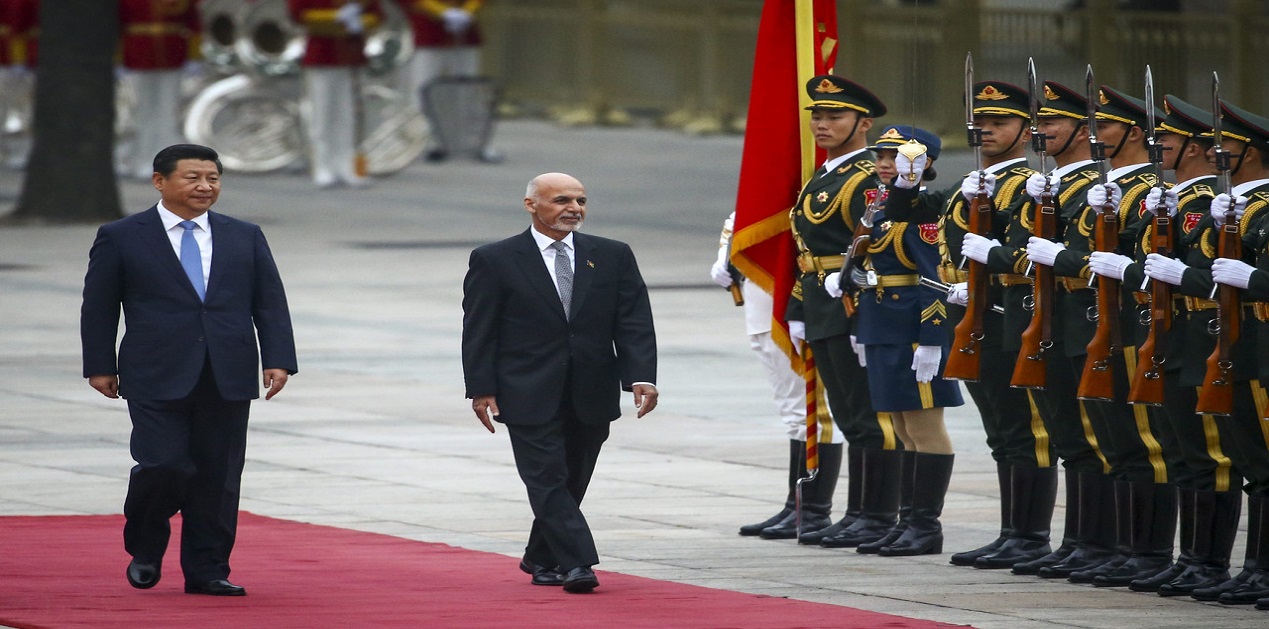As the United States plans to confront China in regions such as Indo-Pacific, it ingenuously is paving the way for Beijing’s rising influence at the heart of the Eurasian continent, i.e. Afghanistan. China’s primary aim in Afghanistan is to ensure that the radical Islamism and Uighur militancy does not seep into its territory through Afghanistan’s Wakhan Corridor, which borders Beijing’s most vulnerable spot- the restive province of Xinjiang. At the same time, stability in Afghanistan is critical for the success of China’s Belt and Road Initiative (BRI) in Central Asia and Pakistan, which includes the China Pakistan Economic Corridor (CPEC).1 China also has a significant interest in curtailing the western influence, and offset India’s role and strategic expansion in the region.2
Recent Developments
COVID-19 pandemic has provided yet another opportunity to China to increase its influence among the SAARC nations, especially Afghanistan. Beijing’s seemingly benign “mask diplomacy”- under which it has supplied medical aid including masks, protective gear and ventilators to countries- has explicit strategic calculations.3 In July 2020, China’s Foreign Minister Wang Yi concluded a virtual meeting with his counterparts from Pakistan, Nepal, and Afghanistan. During the meeting, Beijing urged these countries to forge “four-party cooperation” to control the COVID-19 pandemic and advance the Belt and Road Initiative (BRI), including the CPEC. Foreign Minister Wang even suggested that Nepal and Afghanistan should follow the example of “Sino-Pakistan” cooperation to overcome the pandemic. Recently, China has offered the Taliban “sizeable investments in energy and road infrastructure projects” in the country if they can guarantee peace in Afghanistan.4
As the US brings down its presence in the country, it gives an opportune moment for Beijing to integrate landlocked Afghanistan into the Belt and Road Initiative (BRI) - China’s international infrastructure program infamous for its ‘debt trap’. China’s expansion of BRI into Afghanistan would not only undermine the US and Indian strategic interests in the region but also threatens the aspirations of the Afghan people to create a sovereign, democratic, and financially independent and viable state.
Beijing’s Engagement with Afghanistan
Between 2001 and 2014, when the western and regional players, including India, were spending millions of dollars in security, humanitarian and developmental projects in Afghanistan, China remained at a periphery. During this period, the only significant exceptions were Chinese involvement in Aynak copper mine in 2008 and the Amu Darya oil exploration in 2011. Afghanistan never acquired priority in China’s economic outreach despite the official narrative representing the country as an essential link in Beijing’s Belt and Road Initiative.5 China’s minimal economic investment in the country during this period strengthens the argument concerning Beijing’s marginal economic approach to Afghanistan. Beijing’s direct investment in Afghanistan was minimal USD 2.21 million in 2016 and USD 400 million in 2017.6 At present, there are 12 major Chinese-funded enterprises involved in Afghanistan, including- Petro China, China Railway 14th Bureau, China Metallurgical Group, ZTE Corporation, and Huawei Technologies.7
Comparatively, in Pakistan, China had invested USD 1.58 billion in 2017–2018, bringing the total investment stock to USD 5.7 billion by the end of 2017.8 In this regard, in November 2019, Alice Wells, the then assistant secretary of state for South and Central Asia, criticized China’s role in Afghanistan. Wells said, “China is not a provider of any significant grant assistance. It has invested, or it has laid claim to a copper mine, a significant copper mine, but has never developed the copper mine.”9 She further said: “China has not been a real player in Afghanistan development. I have not seen China take the steps that would make it a real contributor to Afghanistan’s stabilization, much less stitching it back into Central Asia and the international community.”10
After 2015 onwards, in addition to its minimal economic contribution, China began developing ties with Afghanistan in political and security realm as well. In 2016, China, along with Afghanistan, Pakistan, and Tajikistan, formed Quadrilateral Cooperation and Coordination mechanism in Counter-Terrorism.11 Over a period, Beijing has strengthened bilateral security cooperation with Afghanistan mainly to target terrorist outfits linked to the East Turkestan Islamic Movement and Islamic State Khorasan Province (ISKP). Afghanistan has built a military mountain brigade in the Wakhan Corridor in Badakhshan province with the help of China. The fundamental purpose of the mountain brigade is to monitor and thwart infiltration attempts by terrorist groups such as ISKP into China. Between 2016 and 2018, China has contributed over USD 70 million military aid to the Afghan government.
At the same time, in order to forge a more vigorous collaboration between Afghanistan and Pakistan, Beijing has established a trilateral dialogue. The recent round of the trilateral dialogue was held virtually on July 7 2020. The Chinese Vice Foreign Minister Luo Zhaohui, Afghan Deputy Foreign Minister Mirwais Nab, and Pakistani Foreign Secretary Sohail Mahmood attended the meeting. Further, China has strengthened its ties with Kabul by taking the lead in promoting the peace process through various channels, such as the contact group between the Shanghai Cooperation Organization (SCO) and Afghanistan, China-Afghanistan-Pakistan Foreign Ministers Dialogue and China-U.S.-Russia-Pakistan Consultation on Afghanistan, to build comprehensive reconciliation.12
Hedging Strategy with the Taliban
China is making inroads in Afghanistan not only through its close cooperation with the Kabul government but also by its hedging strategy with the Taliban. Previously, China’s close relationship with Pakistan and Pakistani supporters of the Taliban, such as the late Maulana Sami ul Haq, a Pakistani religious scholar and senator known as “the Father of the Taliban”, allowed Beijing to develop ties with the insurgent group in Afghanistan. Beijing’s association with the Taliban goes back to the 1990s when it first forged ties with the insurgent group to curtail the threat of East Turkestan Islamic Movement (ETIM), which operated militant camps in Afghanistan. According to reports, “China’s ambassador to Pakistan, Lu Shulin met Mullah Omar, the supreme Taliban leader, in Kandahar in December 2000.”13
Since 2001, as a neutral player in Afghanistan with no bitter history, China has cultivated ties with both the Kabul government and the Taliban. Nevertheless, China’s close ties with the Taliban also disclose Beijing’s hypocritical policy on terrorism- which includes tyrannizing the Muslim ethnic groups at home as a part of counterterrorism while collaborating with radical Islamist groups like the Taliban in other countries. Apart from various informal bilateral discussions with the Taliban, Beijing formally hosted the insurgent group led by Mullah Ghani Baradar in June 2019 to promote a political settlement between the Kabul government and the Taliban.
Why should Afghanistan be Vigilant of China-led Projects?
The shrinking interest of the US in Afghanistan and the heavy reliance of Kabul administration on foreign aid make it susceptible to the Chinese financial overtures. As Beijing is planning to expand its OBOR initiative to Afghanistan, it is critical for the political elites in Kabul to understand how China’s financial lending and credit policies work and what it means for the future of their country. Firstly, China’s credit and loan policies fall out of the purview of international financial institutions such as the World Bank and IMF and thereby lack transparency and accountability. Without any scrutinizing authority to ensure transparency and accountability, China-led BRI projects pose an immense risk to borrowing countries that are already under enormous fiscal strain. The lack of transparency and accountability while implementing OBOR projects allows state-run Chinese companies to inflate costs and indulge in corruption. Further, any delay or failure in the repayment of loans by the borrowing countries create hindrances in development, and frequently results in the “surrender of strategic assets” and weakens sovereignty.14
The duplicity of Chinese financial aid becomes evident while observing recent cases, such as the Maldives and Sri Lanka, where a lack of transparent bidding and inflated prices led to enormous external debt for the borrowing countries. In the Maldives, to build a new airport runway worth USD 400 million, the officials gave a no-bid contract to China’s ‘Beijing Urban Construction Group’. The Maldives airports company handed over this contract to the Chinese company after cancelling an already existing agreement with an Indian company. Today, the Chinese led projects in the Maldives has hijacked the future of the coming generations as the country is struggling to repay its enormous external debt- half of which is owed to Chinese lenders.
Similarly, in Sri Lanka for the Hambantota port, Beijing loaned over one billion USD despite various studies that questioned the feasibility of the project. The failure to repay the loans by Sri Lankans led to eventual handing over a 99-year lease to Beijing on return for debt relief. Also, in 2018, a study showed that “eight OBOR recipient countries, including Pakistan, Maldives, Tajikistan and Kyrgyzstan, were at high risk of debt stress due to Chinese financing.”15 Also, in case of Myanmar, the risk of sinking in enormous Chinese debt and alarmed by corrupt Chinese financing practices in other parts of the world, the government officials in the country “massively downscaled a deep-water port project in Rakhine State by over 80 percent — from $7.3 billion to $1.3 billion.”16
Therefore, as Afghanistan is working towards carving a more financially independent and self-sufficient future, it needs to be vigilant of the predatory practices of Chinese-led projects. Instead of entirely relying on Beijing after the US withdrawal, Kabul must diversify its economic and strategic engagement. In any case, most of the China-led projects in Afghanistan- in mining, transport infrastructure, and agriculture sector-are either delayed or had been inadequate as compared to its original stated objectives. For example, the most notable Chinese investment in Afghanistan is in the Mes Aynak copper mine, for which Chinese state-owned companies won a 30-year lease for exploration. Since 2008, the project is at a standstill not only due to security issues but also because of the difficulties concerning supply chains. A well-developed mining sector could solve many of Afghanistan’s financial problems; however, the Mes Aynak copper mine deal with China has not resulted in any significant gains for the Afghan economy. As reports suggest, the Kabul government lost USD 2 billion in government revenue “due to inactivity in Mes Aynak Copper Mine” awarded to the Chinese contractor- the China Metallurgical Group Cooperation in Logar province.17
The political elites in Kabul also view China as a constructive partner in the peace process who can wield its influence on Pakistan as well as the Taliban. However, much to the disappointment of the Kabul regime, China has not been able to deliver anything tangible on this front. The continuing violence in Afghanistan indicates the overestimation of claims about China’s ability to control Pakistan, and thereby the Taliban. Much to the annoyance of the Kabul administration, China’s wooing of the Taliban has only emboldened the insurgent group instead of moderating it. As an analyst writes: “Ghani and other top-level Afghan officials were told point blank by their Chinese counterparts that Pakistan remains China’s primary partner in the neighborhood and that Beijing would not squeeze Pakistan the way Afghanistan and the United States have sought on either Afghan militancy or Pakistan’s boycott of Afghan cargo heading to India through its territory.”18
Conclusion
At present, China is using its deep pockets and its influence on Pakistan to carve a larger space for itself in Afghanistan. As space for democratic dispensation in Kabul is shrinking, the expanding Chinese influence in Afghanistan, Iran, and Central Asia is not an uplifting scenario for policymakers in New Delhi and Washington. However, as the political dispensation in Kabul would eventually figure out, China’s dubious economic practices do not make Beijing a desired partner in the long term. Undoubtedly, China brings investment and funds to the table but at a price that is too high to pay. Moreover, as the present situation indicates, instead of controlling Pakistan or the Taliban, China has strengthened the position of these two actors in Afghanistan. Therefore, it is imperative for the ruling dispensation in Afghanistan, to engage other partners, such as Indians and Europeans, sufficiently to avoid overdependence on Beijing. At the same time, India must strengthen its developmental and security commitment to Afghanistan and convince its American and other western partners to deliver the same. It is critical for Washington and New Delhi to forge a comprehensive understanding of Chinese expansionism around the world rather than focusing on countering it only in the Indo-Pacific. Ignoring Afghanistan in this new great game will come at an exorbitantly high price for both India and the United States.
- Vanda Felbab Brown, “A bridge too far: the unfulfilled promise and limitations of China’s involvement in Afghanistan”, June 2020, Brookings Institute, URL: https://www.brookings.edu/wp-content/uploads/2020/06/FP_20200615_china_afghanistan_felbab_brown.pdf , p. 3
- Enhancing security and stability in Afghanistan, December 2019, Report to Congress, URL: https://media.defense.gov/2020/Jan/23/2002238296/-1/-1/1/1225-REPORT-DECEMBER-2019.PDF , p. 24
- Mustafa Sarwar, China Ramps Up Role In Afghanistan Ahead of U.S. Withdrawal, Radio Free Afghanistan, 5 May 2020, URL: https://gandhara.rferl.org/a/china-ramps-up-role-in-afghanistan-ahead-of-u-s-withdrawal-/30594555.html
- China offers Taliban road network in exchange for peace, Financial Times, 8 September 2020, URL: https://www.ft.com/content/69110b85-bce9-45cb-a2f4-eadcd3edc6e3
- Yun Sun, China’s strategic assessment of Afghanistan, 8 April 2020, War on the Rocks, URL: https://warontherocks.com/2020/04/chinas-strategic-assessment-of-afghanistan/
- Ibid
- China’s council for the promotion of International Trade, URL: http://www.ccpit.org/Contents/Channel_4128/2018/1225/1106153/content_1106153.htm
- Ministry of Commerce, PRC, URL: http://yzs.mofcom.gov.cn/article/t/201902/20190202836085.shtml
- Vinay Kaura, What does China’s growing engagement in Afghanistan mean for the US? , 7 August 2020, URL: https://www.mei.edu/publications/what-does-chinas-growing-engagement-afghanistan-mean-us
- Ibid
- Ministry of National Defence, PRC, URL: http://eng.mod.gov.cn/DefenseNews/2016-08/04/content_4707451.htm?mc_cid=a354509b5e&mc_eid=4b516b0c01
- Envoy elaborates China's position on Afghanistan, Xinhuanet, 28 November 2019, URL: http://www.xinhuanet.com/english/2019-11/28/c_138588110.htm
- Vinay Kaura, What does China’s growing engagement in Afghanistan mean for the US? , 7 August 2020, URL: https://www.mei.edu/publications/what-does-chinas-growing-engagement-afghanistan-mean-us
- A Conversation with Ambassador Alice Wells on the China-Pakistan Economic Corridor, US Department of State, 21 November 2019, URL: https://www.state.gov/a-conversation-with-ambassador-alice-wells-on-the-china-pakistan-economic-corridor/
- A Conversation with Ambassador Alice Wells on the China-Pakistan Economic Corridor, US Department of State, 21 November 2019, URL: https://www.state.gov/a-conversation-with-ambassador-alice-wells-on-the-china-pakistan-economic-corridor/
- Ibid
- More than $2B Lost in Copper Mining Delays: Company, TOLO News, 7 March 2020, URL: https://tolonews.com/business/more-2b-lost-copper-mining-delays-company
- Vanda Felbab Brown, “A bridge too far: the unfulfilled promise and limitations of China’s involvement in Afghanistan”, June 2020, Brookings Institute, URL: https://www.brookings.edu/wp-content/uploads/2020/06/FP_20200615_china_afghanistan_felbab_brown.pdf
(The paper is the author’s individual scholastic articulation. The author certifies that the article/paper is original in content, unpublished and it has not been submitted for publication/web upload elsewhere, and that the facts and figures quoted are duly referenced, as needed, and are believed to be correct). (The paper does not necessarily represent the organisational stance... More >>
Image Source: https://images.indianexpress.com/2020/08/Trump-Biden-759.jpg











Post new comment